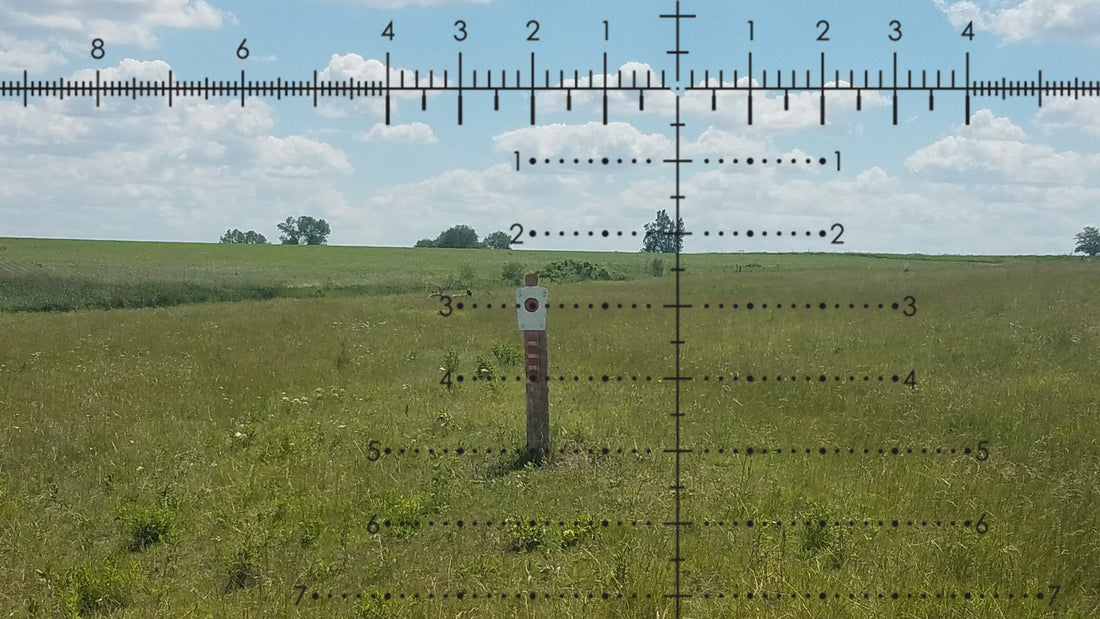Whether to dial a turret adjustment or use a reticle hold is a much debated and controversial topic in the long range shooting community. Given that there are multiple shooting disciplines and because each discipline can vary wildly from the others, there's no right or wrong answer when it comes to effective employment of your sights for a target engagement. But there could be a more right or more wrong solution depending on how the shooter intends to best utilize the sighting system for a given engagement scenario. You won't find the conclusive answer here (because there isn't one), but you will find recommendations for best sight employment when considering different target engagement scenarios. Let's begin....
We first need to consider the general advantages and disadvantages of dialing and holding:
Dialing
Pros:
- Simplifies the use of sights by making the reticle point of aim (POA) the point of impact (POI).
- Minimizes the possibility of operator error for a single point-and-shoot target engagement.
- Allows for finite sight adjustment which may otherwise not be possible without a reticle designed specifically for holds.
- May give a greater range of overall elevation adjustment compared to a holdover reticle.
- Reticles intended for dialing are generally "less busy" which allows for easier trace and impact observation by the shooter.
Cons:
- Dialing can be slow and cumbersome in the heat of the moment during multi-target engagements.
- Dialed adjustment is more likely to have some amount of error in the mechanical mechanism compared to an etched reticle.
- It's easier to "get lost in your sights" without a zero stop mechanism.
Holding
Pros:
- Extremely fast and effective for rapid, dynamic, and multi-target engagement scenarios.
- Some holdover reticles such as the Horus TREMOR 3 have some very practical ranging and moving target design features.
- Greater employment flexibility for a wide range of scenarios requiring dialing, holds, or a combination of both.
- Etched reticles generally have less adjustment error than a turret adjustment mechanism.
- It's almost impossible to "get lost in your sights / turrets" regardless of whether the scope has a zero stop feature.
Cons:
- Holdover reticles can be quite "busy," which allows shooters to "get lost in the reticle" during engagements.
- Generally takes some amount of time and practice to become proficient in holdover reticle use.
- Some reticles do not provide a shooter with finite hold adjustment, making it difficult to hold an exact elevation or wind value.
- Some reticle designs may not provide a shooter with a large amount of elevation hold.
With those general advantages and disadvantages outlined, let's consider some unique target engagement scenarios which highlight the various situations a shooter may benefit from dialing, holdovers, or both:
Engagement One
Target shooting disciplines such as F-Class typically require the shooter to dial elevation adjustments to be competitive. The X ring is usually 1/2 MOA, so about 5 inches at the 1000 yard berm. Consider that 1 MOA equals 10.47 inches at 1000 yards and the X ring is half that! A shooter aiming at the center of the X ring has a 2.5 inch radius before the bullet falls outside the X scoring zone. If the shooter was to hold for elevation, the reticle hold would have to be accurate to less than 0.25 MOA to place all shoots inside the X scoring zone. That's an incredibly precise reticle hold. Convert that to MIL, the hold would need to be accurate within 0.07 MIL. Additionally, the shooter would have to reset with the precise hold after each shot versus realigning the central POA onto the target. There's more probability for hold errors and mistakes in that scenario. Sometimes it just makes sense to dial.
Engagement Two
A multi-target engagement at various engagement ranges can be tackled a lot more effectively with holdovers. Time and time again I've seen shooters run through a stage dialing adjustments between target engagements. It's slow and cumbersome with more chance of dialing error in the heat of the moment, especially if more than one turret revolution is required for adjustment. Dialing also requires the shooter to come off glass to confirm the dialed elevation and then find the target again when back on glass. All of these things take time, which reduces the effectiveness of the shooter to engage multiple targets in a reduced timeframe. Multi-target scenarios typically have more forgiving target sizes than your average FTR disciplines, which makes rapid reticle holds a very viable option.
Engagement Three
Let's dive into the Extreme Long-Range (ELR) world for a minute. The ELR discipline is unique, and requires shooters to engage 36x36 inch targets at ranges that typically start around 1-mile and can exceed 2-miles. The idea that a shooter would employ reticle holds to engage ELR targets without dialing some amount seems ridiculous. Consider the elevation required for a 0.375 caliber Berger 407gr solid launched at 2850 fps for 1 and 2 mile target distances. The 1-mile target requires just over 15 MIL of elevation at mean sea level (MSL). The 2-mile target requires just over 60 MIL of elevation. A shooter might be able to hold the 15 MIL for the 1-mile target if using a H59 or TREMOR 3 reticle, but that would also require reduced magnification to make the 15 MIL of hold viewable for use. Being limited by reduced magnification for ELR target ranges is not ideal, and is also completely avoidable by the use of dialing.
What about the 2-mile target you say! With the right ELR weapon configuration, the shooter could get nearly 30 MIL of effective elevation from the turret. That leaves the shooter wanting for another 30 MIL. Enter the Tacom HQ Charlie TARAC periscope or the Nightforce Prism for the remaining elevation... It's more likely the shooter might have 20-25 MIL of elevation in the turret, and 30 MIL from the periscope. The ideal solution is to attach the periscope and dial out a round amount of elevation. Periscopes and prisms don't always calibrate to exactly 30 MIL. In this example the periscope calibrates to 29.6 MIL so the shooter dials an additional 24.4 MIL and holds the remaining 6 MIL to make up the 60 MIL total.
ELR shooters can struggle to identify the splash of a round at extreme distances, so some shooters employ a tactic to help minimize the wind uncertainty. Once bullet splash has been observed, the shooter rapidly realigns on the target with a wind hold and fires the remaining volley of shots in rapid succession. This minimizes the variable wind uncertainty the shooter is firing within by trying to fire all shots in a short timeframe within a similar wind condition. This type of engagement can be best handled with a combination of dialing for the first round, and holding for both elevation and wind for subsequent follow up shots.
Engagement Four
Some stages on Precision Rifle Series (PRS) matches have multiple targets positioned at the same range, usually requiring the shooter to move between firing points while switching fire onto alternating targets. This is a good example of a scenario which would be conducive to dialing for a POA POI zero. It allows for the shooter to set and forget the sights, and concentrate on conducting the stage. The shooter is looking to align the crosshair on the center of the target each time he or she gets back on glass, rather than searching for a hold value in the reticle. That simplicity will shave valuable seconds off for a time limit that might already be challenging.
Engagement Five
The elephant in the room is moving target engagements. This can be a tricky scenario to navigate, especially if there are multiple moving targets at differing speeds at multiple ranges. Each target requires a new elevation, windage, and lead hold for the engagement. That's a lot of mental calculation to be hashed out behind the bolt for windage and lead values. It might not be difficult to rattle off the numbers for some shooters, but others may prefer to dial out elevation and windage and then just hold for lead.
The shooter who opts to dial out elevation and windage is probably aware of the slight time disadvantage between target engagements, but may value simplifying things with only a reticle hold for leading the target. Conversely, the shooter who opts to engage each target with a reticle hold for elevation, windage and lead has some mental math to do in the moment. Maybe the shooter performs well under pressure, or maybe the shooter flunks the math which causes some misses. It's a constant analysis of advantages and disadvantages whichever way the shooter decides to conduct the engagement, but holding a lead value is almost always the way to go. If a shooter dialed a lead value and the target changed direction or speed, or both, the shooter would be forced to correct the windage dial and realign with a new dialed lead value. Constantly being off the glass to dial an adjustment isn't conducive to effective mover engagement where the shooter would otherwise quickly adjust the hold before snapping off the next round.
All Things Considered
There's no right or wrong answer as to whether a shooter should dial or hold. But the shooter should always weigh the advantages and disadvantages of each against the type of target engagement scenario. Some engagement scenarios are better suited to dialing, holds might be more conducive for others, or a mixture of both.
Thanks for reading. If you enjoyed this content, be sure to subscribe, share, and follow us on YouTube, Facebook, and Instagram.

